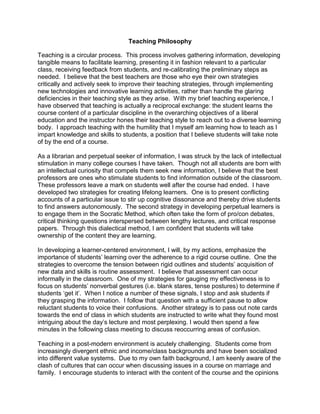
Teaching Philosophy
- 1. Teaching Philosophy Teaching is a circular process. This process involves gathering information, developing tangible means to facilitate learning, presenting it in fashion relevant to a particular class, receiving feedback from students, and re-calibrating the preliminary steps as needed. I believe that the best teachers are those who eye their own strategies critically and actively seek to improve their teaching strategies, through implementing new technologies and innovative learning activities, rather than handle the glaring deficiencies in their teaching style as they arise. With my brief teaching experience, I have observed that teaching is actually a reciprocal exchange: the student learns the course content of a particular discipline in the overarching objectives of a liberal education and the instructor hones their teaching style to reach out to a diverse learning body. I approach teaching with the humility that I myself am learning how to teach as I impart knowledge and skills to students, a position that I believe students will take note of by the end of a course. As a librarian and perpetual seeker of information, I was struck by the lack of intellectual stimulation in many college courses I have taken. Though not all students are born with an intellectual curiosity that compels them seek new information, I believe that the best professors are ones who stimulate students to find information outside of the classroom. These professors leave a mark on students well after the course had ended. I have developed two strategies for creating lifelong learners. One is to present conflicting accounts of a particular issue to stir up cognitive dissonance and thereby drive students to find answers autonomously. The second strategy in developing perpetual learners is to engage them in the Socratic Method, which often take the form of pro/con debates, critical thinking questions interspersed between lengthy lectures, and critical response papers. Through this dialectical method, I am confident that students will take ownership of the content they are learning. In developing a learner-centered environment, I will, by my actions, emphasize the importance of students’ learning over the adherence to a rigid course outline. One the strategies to overcome the tension between rigid outlines and students’ acquisition of new data and skills is routine assessment. I believe that assessment can occur informally in the classroom. One of my strategies for gauging my effectiveness is to focus on students’ nonverbal gestures (i.e. blank stares, tense postures) to determine if students ‘get it’. When I notice a number of these signals, I stop and ask students if they grasping the information. I follow that question with a sufficient pause to allow reluctant students to voice their confusions. Another strategy is to pass out note cards towards the end of class in which students are instructed to write what they found most intriguing about the day’s lecture and most perplexing. I would then spend a few minutes in the following class meeting to discuss reoccurring areas of confusion. Teaching in a post-modern environment is acutely challenging. Students come from increasingly divergent ethnic and income/class backgrounds and have been socialized into different value systems. Due to my own faith background, I am keenly aware of the clash of cultures that can occur when discussing issues in a course on marriage and family. I encourage students to interact with the content of the course and the opinions
- 2. of their peers in a civil fashion. One of the latent objectives of my teaching style is to help students understand how different value orientations and racial/ethnic and socioeconomic backgrounds shape how we interpret the social world. In doing so, students will appreciate diversity not for the novelty of diversity but for its ability to understanding the world holistically. I approach teaching sociology as a ‘debunker of social myths’, as sociologist Peter Berger suggests. I strive to move students beyond ‘pro’ and ‘con’ arguments to a synthesis of different accounts of reality that transcends dichotomous thinking about a topic. I believe that the most rewarding part of teaching is the ‘a-ha’ moments that teaching affords, moments where students see new light on issues that were previously resolved in their minds. I seek to move students in my classes from mere receptacles for my knowledge to individuals whose evaluate and synthesize ideas, articulate their beliefs and engage the beliefs of others, and integrate of new perspectives with pre- existing beliefs. I strive to make students aware of their intellectual potential through my teaching and encourage them to go beyond a superficial grasp of the course’s content.
